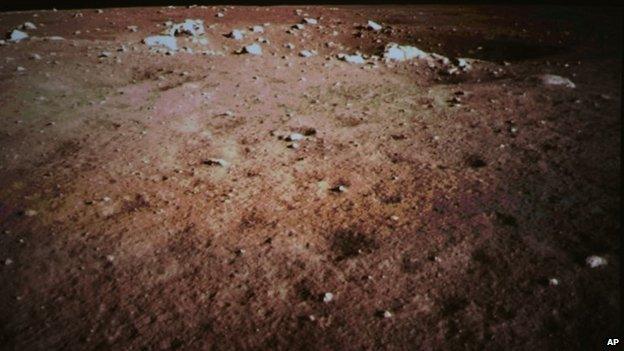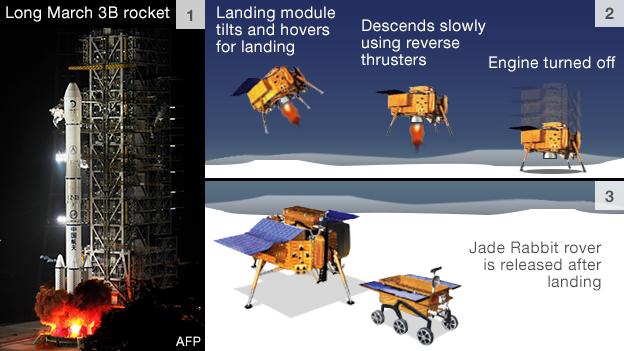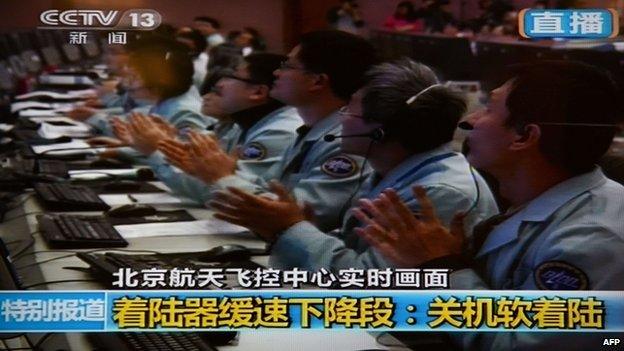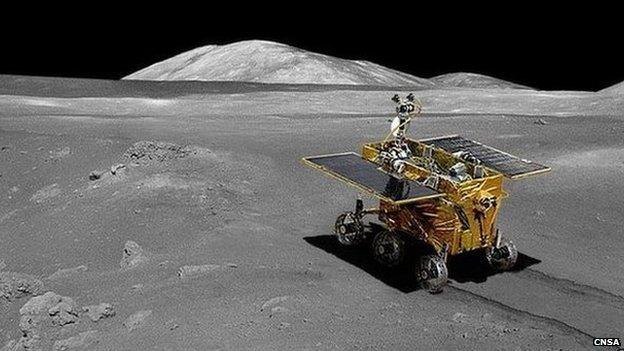China lands Jade Rabbit robot rover on Moon
- Published

The lander has touched down on a flat plain known as Sinus Iridum (the Bay of Rainbows)
China says it has successfully landed a craft carrying a robotic rover on the surface of the Moon, the first soft landing there for 37 years.
On Saturday afternoon (GMT), a landing module used thrusters to touch down, marking the latest step in China's ambitious space exploration programme.
Several hours later, the lander will deploy a robotic rover called Yutu, which translates as "Jade Rabbit".
The touchdown took place on a flat plain called Sinus Iridum.
The Chang'e-3 mission launched atop a Chinese-developed Long March 3B rocket on 1 December from Xichang in the country's south.
China's space mission team celebrate after the landing
The official Xinhua news service, external reported that the craft began its descent just after 1300 GMT (2100 Beijing time), touching down in Sinus Iridum (the Bay of Rainbows) 11 minutes later.
State television showed pictures of the moon's surface as the lander touched down and an eye-level view of the landing site was released later on Saturday. Staff at mission control in Beijing clapped and celebrated after confirmation came through.
The probe's soft-landing was the most difficult task during the mission, Wu Weiren, the lunar programme's chief designer, told Xinhua.
It is the third robotic rover mission to land on the lunar surface, but the Chinese vehicle carries a more sophisticated payload than previous missions, including ground-penetrating radar which will gather measurements of the lunar soil and crust.
"It's still a significant technological challenge to land on another world," said Peter Bond, consultant editor for Jane's Space Systems and Industry, external told the AP news agency.
"You have to use rocket motors for the descent and you have to make sure you go down at the right angle and the right rate of descent and you don't end up in a crater or on top of a large rock."
The landing module actively reduced its speed at about 15km from the Moon's surface.
When it reached a distance of 100m from the surface, the craft fired thrusters to slow its descent.
At a distance of 4m, the lander switched off the thrusters and fell to the lunar surface.
The Jade Rabbit was expected to be deployed several hours after touchdown, driving down a ramp lowered by the landing module.

Reports suggest the lander and rover will photograph each other at some point on Sunday.
According to Chinese space scientists, the mission is designed to test new technologies, gather scientific data and build intellectual expertise, as well as scouting for mineral resources that could eventually be mined.
"China's lunar program is an important component of mankind's activities to explore [the] peaceful use of space," said Sun Huixian, a space engineer with the Chinese lunar programme.
The 120kg (260lb) Jade Rabbit rover can reportedly climb slopes of up to 30 degrees and travel at 200m (660ft) per hour.
Its name - chosen in an online poll of 3.4 million voters - derives from an ancient Chinese myth about a rabbit living on the moon as the pet of the lunar goddess Chang'e.
The rover and lander are powered by solar panels but some sources suggest they also carry radioisotope heating units (RHUs), containing plutonium-238 to keep them warm during the cold lunar night.
Dean Cheng, external, a senior research fellow at the Heritage Foundation, external, a conservative think-tank in Washington DC, said China's space programme was a good fit with China's concept of "comprehensive national power". This might be described as a measure of a state's all-round capabilities.
Space exploration was, he told BBC News, "a reflection of your economic power, because you need spare resources to have a space programme. It clearly has military implications because so much space technology is dual use".
He added: "It reflects your scientific and technological capabilities, it supports your diplomacy by making you appear strong.
"China is saying: 'We are doing something that only two other countries have done before - the US and the Soviet Union."
The Chang'e-3 mission launches from Xichang, south China
Mr Cheng explained that the mission would also advertise the country as a destination for commercial space launches, as well as providing an opportunity to test China's deep-space tracking and communications.
"The rover will reportedly be under Earth control at various points of its manoeuvres on the lunar surface," Mr Cheng wrote in a blog post, external.
"Such a space observation and tracking system has implications not only for space exploration but for national security, as it can be used to maintain space surveillance, keeping watch over Chinese and other nations' space assets."
China has been methodically and patiently building up the key elements needed for an advanced space programme - from launchers to manned missions in Earth orbit to unmanned planetary craft - and it is investing heavily.

Scientists celebrated at the control centre in Beijing after Chin's first lunar rover touched down

The Jade Rabbit, seen in this artist's impression, is the first wheeled vehicle on the Moon since the 1970s

A giant screen at the Beijing Aerospace Control Center in Beijing showed an animated image of the module landing on the Moon
"China wants to go to the Moon for geostrategic reasons and domestic legitimacy," Prof Joan Johnson-Freese, of the US Naval War College, external in Rhode Island, told the AFP news agency.
"With the US exploration moribund at best, that opens a window for China to be perceived as the global technology leader - though the US still has more, and more advanced, assets in space."
The landing site is a flat volcanic plain, part of a larger feature known as Mare Imbrium that forms the right eye of the "Man in the Moon".
The lander will operate there for a year, while the rover is expected to work for some three months.
After this, a mission to bring samples of lunar soil back to Earth is planned for 2017. And this may set the stage for further robotic missions, and - perhaps - a crewed lunar mission in the 2020s.
Paul.Rincon-INTERNET@bbc.co.uk and follow me on Twitter, external
- Published1 December 2013
- Published29 November 2013
- Published24 June 2013
- Published11 June 2013